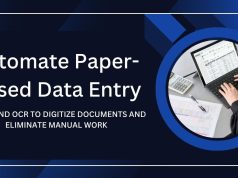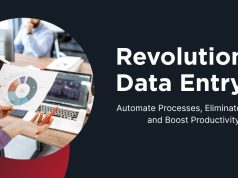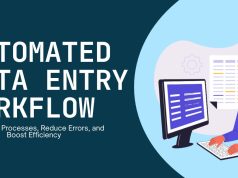In today’s fast-paced business environment, organizations operate with diverse applications and legacy systems, spreadsheets, cloud portals, and databases. Manually entering data between these platforms is time-consuming, error prone, and hinders productivity. Cross-platform data entry automation solves this by orchestrating workflows that seamlessly move information from one system to another without human intervention.
By combining Robotic Process Automation (RPA), Python scripting, and artificial intelligence (AI), you can build a robust solution that handles everything from simple record transfers to intelligent data validation and enrichment. This comprehensive guide explores the benefits, challenges, tools, and best practices for implementing a cross-platform data entry automation strategy that accelerates operations and reduces operational risk.
Why Cross-Platform Automation Matters
Enterprises often juggle multiple data sources such as CRM systems, ERP modules, web portals, and local files. Without integration, employees spend hours copying, pasting, and reconciling discrepancies. Cross-platform automation eliminates these manual handoffs, ensuring data consistency and real-time synchronization across the entire technology stack. The result is faster decision making, improved data quality, and significant cost savings.

Key Challenges in Cross-Platform Data Entry
Implementing cross-platform automation is not without hurdles. Common challenges include dealing with heterogeneous interfaces, locking mechanisms on files, throttling limits on web APIs, and data format mismatches. Security concerns such as credentials management and audit trails must also be addressed to comply with internal policies and industry regulations. Planning for these obstacles in advance is critical to project success.
Core Tools: RPA, Python, and AI
Robotic Process Automation (RPA) platforms such as UiPath, Automation Anywhere, and Microsoft Power Automate excel at interacting with user interfaces in a human-like way. They can log into applications, click buttons, and extract on-screen data. RPA acts as the glue between systems that lack modern APIs or connectors, making it indispensable for legacy integration.
Python is a versatile scripting language with rich libraries for web requests, database connectivity, Excel manipulation, and JSON or XML processing. By embedding Python scripts into RPA workflows or running them independently, developers can handle complex logic, transform data structures, and integrate with RESTful APIs far more efficiently than through UI automation alone.
Artificial Intelligence enhances automation by adding capabilities such as document classification, optical character recognition (OCR), and anomaly detection. AI models can read scanned invoices, validate address data against postal databases, or flag outliers in datasets. When integrated into an automated pipeline, these intelligent layers further reduce manual review and increase trust in the results.
Step-by-Step Guide to Implementing a Cross-Platform Automation Solution

1. Assess Your Requirements
Begin by mapping out the data sources, target applications, and formats involved. Identify high-volume or error-prone tasks suitable for automation. Determine system access methods (UI, API, database) and any security or compliance restrictions. Establish success metrics such as time saved, error reduction rate, and return on investment (ROI).
2. Select Your RPA Platform
Evaluate leading RPA vendors based on ease of use, available connectors, scalability, licensing costs, and support for attended versus unattended robots. Choose a platform that integrates well with your infrastructure and provides a low-code environment for business analysts, while offering advanced features for developers when necessary.
3. Develop Python Integration Scripts
Write modular Python scripts to handle data transformation, API calls, database updates, and file processing. Utilize libraries such as requests, pandas, openpyxl, and SQLAlchemy. Design scripts with clear input and output parameters so they can be invoked by RPA workflows or scheduled independently via task schedulers or CI/CD pipelines.
4. Incorporate AI for Data Validation & Enrichment
Integrate OCR engines like Tesseract or cloud services such as Azure Cognitive Services to extract text from scanned documents. Use trained machine learning models for classification or to detect anomalies in incoming data. Embed these AI calls within your Python scripts or trigger them directly from the RPA orchestrator to enhance accuracy and minimize manual checks.
5. Test and Deploy
Conduct thorough testing in a sandbox environment covering edge cases, connectivity failures, and exception scenarios. Implement retry mechanisms and logging for traceability. Once validated, deploy the solution in production, monitor performance metrics, and collect user feedback for continuous improvement.
Real-World Case Study: Building a Unified Automation Platform
A mid-sized logistics company struggled with manual data entry between its order management system, billing portal, and Excel-based reporting. By deploying an RPA bot to extract order details from the OMS, invoking Python scripts to calculate freight costs and taxes, and then uploading the invoice data to the billing portal, they reduced process time from two hours per day to under five minutes. An AI model further validated shipping addresses, cutting delivery errors by 30%.
The implementation leveraged a CI/CD pipeline to version control Python scripts, containerize them, and orchestrate deployment alongside RPA workflows. Detailed logging and dashboards provided real-time visibility into job status, exception rates, and overall system health, enabling the operations team to proactively address issues before they impacted customers.

Best Practices for Maintaining and Scaling Your Solution
Adopt a modular architecture where each component—RPA, Python, AI—is decoupled and independently deployable. Use version control systems like Git for scripts and workflow definitions. Implement centralized credential management and follow least-privilege principles. Schedule regular reviews of exception logs to refine rules and retrain AI models as data patterns evolve.
Plan for scale by employing distributed runtimes or robot farms that can run jobs in parallel. Leverage cloud resources for compute-intensive tasks such as image recognition or large-volume API processing. Establish governance around change management to ensure new workflows are tested and documented before going live.
Conclusion
Cross-platform data entry automation empowers organizations to eliminate repetitive tasks, accelerate processing times, and enhance data quality. By combining the interface-driving power of RPA, the flexibility of Python scripting, and the intelligence of AI, you can build end-to-end workflows that operate flawlessly across disparate systems. The initial investment in planning and tool selection pays dividends through reduced labor costs, fewer errors, and greater agility.
Ready to transform your operations? Begin with a pilot project targeting a high-volume process, apply the steps outlined in this guide, and scale up based on measurable success. With the right strategy, cross-platform data entry automation will become the backbone of a smarter, more efficient enterprise.










